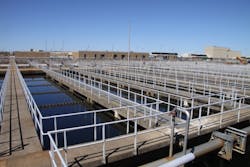Covering more than 150 acres along the Potomac River at the southernmost tip of Washington, DC Water’s Blue Plains is the largest advanced wastewater treatment facility in the world. With evolving environmental regulations and a growing population, the plant is undertaking two major capital improvement projects geared toward protecting the Chesapeake Bay watershed. Emerson Process Management is helping with these efforts through its Ovation control system, which will help DC Water optimize operations of its new facilities.
The Chesapeake Bay watershed covers some 64,000 square miles, serving about 17 million people in Delaware, Maryland, New York, Pennsylvania, Virginia, West Virginia and Washington, D.C. Hundreds of wastewater treatment facilities throughout the watershed are upgrading their technologies to reduce the amount of nutrients that are discharged into Chesapeake Bay's tributaries. Upgrades have already had a significant impact on nutrient reductions, and jurisdictions are relying on additional reductions from wastewater to achieve about 15 percent of the nutrient reduction goals.
Blue Plains, with a capacity of 370 millions gallons per day (MGD) will use two projects—Enhanced Nutrient Removal, and Thermal Hydrolysis and Anaerobic Digestion—to help it comply with the goals.
The plant uses a sophisticated nitrification/denitrification and filtration process to reduce the amount of nitrogen in the water. Excess nitrogen causes an overgrowth of aquatic plants and algae, which takes oxygen from the water that fish and other aquatic life need to survive. The $950 million Enhanced Nutrient Removal project is designed to reduce almost to the “limit of technology” the level of nitrogen that DC Water discharges to the Potomac River. Ovation technology will monitor and control all major equipment and processes related to the project. Once the project is complete, Blue Plains will be able to produce effluent with some of the lowest levels of nitrogen in the country, especially for a plant of its size.
The second project, Thermal Hydrolysis and Anaerobic Digestion, will enable DC Water to reduce biosolids by 50 percent. This will not only slash CO2 emissions associated with hauling biosolids away by up to 60 tons, but will also allow DC Water to burn the methane gas byproduct to generate electricity that will help offset power by one-third for its operations. Additionally, the remaining Class A biosolids will have greater commercial value because they offer more reuse options as a fertilizer than the plant’s current biosolids.
The control system will monitor and control the anaerobic digesters, final dewatering and other equipment and processes related to this major initiative, and will interface to the combined heat and power plant. Developed by Norway-based Cambi, the innovative thermal hydrolysis process is already being used to treat wastewater in Europe and Australia. Blue Plains will become the largest plant in the world to use the innovative technology, and the first plant in North America.
Emerson has been working with DC Water for more than 10 years. In 2002, the authority began a multi-year plant modernization project that included adopting a long-term automation plan using a common control platform, based on Ovation technology, throughout its operations. This approach has made it possible for DC Water to more seamlessly integrate new facilities and processes needed to meet evolving circumstances, such as growing environmental regulations and population growth.
“Over the last decade or so we have had a very positive, collaborative relationship with DC Water—one we look forward to continuing as we work together on these ambitious projects,” said Bob Yeager, president of Emerson Process Management’s Power & Water Solutions.

